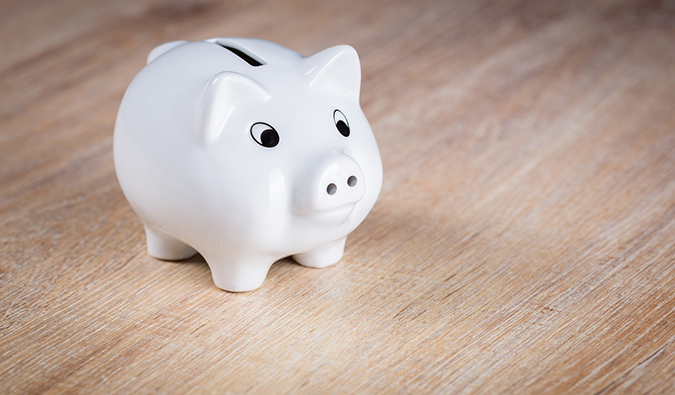23 Ways to Cut Your Expenses and Have More Money for Travel

Get out a sheet of paper and write down all your set expenses: rent/mortgage, car payments, cable/streaming bill, cell phone, insurance, school payments, etc. Tally them up.
Then write down all your discretionary spending. This is what you spend on food, movie nights, drinks, shopping, that daily coffee from Starbucks, cigarettes, sports tickets, your daily midday snack, and other similar things. If you don’t know what you spend money on, go track your expenses for a two-week period, see what you spend, and come back.
Add that all up — what did you get? Probably a large sum of money.
And I bet there will be many expenses you didn’t realize were there. Financial experts call these “phantom expenses” — we never know they are there because the expenses are so small. People bleed money without realizing it. A dollar here and a dollar there adds up. Even a daily bottle of water or candy bar can make a substantial difference over the course of a year.
What does this have to do with travel?
One of the main reasons why you think you can’t travel the world is money. “I can’t afford it,” people say to me, “I have too many expenses.” Most of us certainly have expenses we can’t cut (though remember when you travel the world long-term, many of those expenses disappear), but if we cut our phantom expenses, reduce our set costs, and find other ways to save we can build our travel fund much more quickly.
In short, if you want to start traveling more or save up for a specific trip, you need to create a budget. This will let you see where you can make cuts and where every penny you earn is being spent.
Cutting your daily expenses, being more frugal, and downgrading to a simpler way of living will allow you to save money for your trip around the world without having to find extra sources of income. I know these tips work because I used them before my first round-the-world trip (and still use them to keep my living expenses low).
Of course, the lower your income, the longer it will take to save enough to travel. But longer doe not mean never. A little bit every day adds up to a lot over a long period of time.
Here are some simple and creative ways to cut your expenses, make money, and get on the road sooner:
1. Track your spending
As mentioned in the introduction, most people don’t have a budget so the first thing you need to do to save money is to know where you’re spending it. In an age where you tap an app and a car comes, it’s easy to not think about how much we spend. Create a spreadsheet or use a service like Mint and track all your expenses. You’ll probably be surprised at where your money goes once you start paying attention. I live in Austin and I found myself realizing I was spending close to $100 USD a month on escooter rides. The distances I take them aren’t that far and, since the weather is usually nice, I decided to start walking more. It’s healthier and cheaper. That’s a $1,200 a year savings (i.e. a few months in Southeast Asia!)
Start tracking your expenses – and keep doing so – so you can keep cutting out the low hanging fruit and find where you’re spending money. You can use a spreadsheet or website like Mint or Onomy to do so.
2. Set up a separate bank account
Financial experts have long recommended this. Set up a separate bank account and have money automatically deposited into that account each pay cycle. No matter how much you put away there, putting that money in a separate bank account means it’s away from your spending and you won’t overspend. Think of this like a piggy bank. Don’t raid it. It’s your travel fund.
3. Cut the coffee
Love your Starbucks? Well, Starbucks loves your money. Coffee is a daily expense that quietly drains your bank account without you even noticing. That daily $5 USD coffee costs you $150 USD per month. At $1,800 USD per year, that’s two months in Southeast Asia.
What’s more important: your daily cup of Joe or spending more time on the beaches of Thailand or exploring the jungles of Borneo?
Sure, giving up your cup of coffee seems like a “duh” thing. And, yes, there is utility in the time saved from buying one. Under normal circumstances, this would be “small thinking” financial advice that isn’t worth the time or effort.
But, right now, you have a travel goal to reach and every penny counts.
4. Learn to cook
We all need to eat but restaurants are expensive. To keep your food bill low, cook more often. I learned to cook while in college (a skill that has helped me ever since) and before I left for my first trip, I cut down my eating out to two times per week. Every other meal I cooked myself. I would save the leftovers from dinner for lunch the next day, thus saving more money.
You don’t need to be a whiz in the kitchen, either. There are a million and one cooking sites, YouTube videos, and recipe blogs that will teach you how to cook fast and healthy meals. I never spend more than 20-30 minutes making a meal.
Here are some sites to check out to get the ball rolling:
5. Lose the car
Between insurance, repairs, loan payments, and filling your tank with gas, cars are crazy expensive to own. Get rid of your car if you can. Learn to love the bus, take the subway, bike, or walk. It may take longer to get to work using public transportation, but you can use that time to plan your trip, read, write, or do other productive tasks.
I understand that this tip may not be feasible for everyone, especially those in smaller towns that don’t have an extensive public transportation system, but an alternative is to sell your car and buy a cheaper used one, which you will only need until you leave for your trip. Buying a throwaway car will allow you to pocket the money from your more expensive car and put it toward your travels.
Additionally, with the proliferation of Uber, Lyft, and other ride-sharing services, it’s never been easier, even in small towns, to find transportation. Do the math on it but it may be cheaper to get Lyfts around town than to own a car. (Plus, if you need a car for long distances, you can easily rent one.)
6. Save on Gas
Gas adds up! Luckily, there’s plenty of ways to save on gas! First, use the app GasBuddy to find cheap gas near you. Second, sign up for all the major gas station loyalty programs. By default, they save you around 5 cents per gallon. Shell’s Fuel Rewards is the best because you attached it to a dining program leading to savings up to 50 cents a gallon. Moreover, use GasBuddy’s credit card, which can be tied to any of these loyalty programs and then used for an additional savings of 25 cents per gallon. Most supermarkets also have loyalty programs that offer gas savings. And, if you sign up for Costco, they have huge savings too.
7. Stream!
In the age of Hulu and free (and legal) streaming TV, there’s no reason for you to be spending $50 USD per month on cable television. Get rid of it and just watch everything online for free. You can also start sharing your streaming costs with friends or family. Standard Netflix is $12.99 USD per month. If you can cut that in half by splitting it with a friend, you’ll save a few bucks.
8. Downgrade your phone
The average American phone bill is over $100 USD per month. While smartphones are handy devices, getting a cheap phone without any fancy apps will cut your monthly phone bill in half (if not more). You might get bored on the train not being able to read the news, but saving an extra $600-800 USD a year will allow you to spend a few more weeks in Europe, buy fancier meals, or learn to scuba dive in Fiji.
Consider buying a simple flip phone or even a refurbished phone. You’ll waste less time online and save money. Double win!
9. Get a new credit card
A travel credit card can give you free money, free rooms, and free flights. After accruing miles and rewards points with your card on everyday purchases, you can redeem them for free travel on your trip. Travel credit cards are a big weapon in a budget traveler’s arsenal. You’ll even earn huge sign-up bonuses when you get a new card.
When used properly, these cards generate free money so start early. As soon as you decide to travel the world, get a travel-related credit card and begin earning points on your daily purchases. A few credit cards worth checking out are:
- Chase Sapphire Reserve – The best card on the market, offering 3x points on restaurants and travel, lounge access, and over $300 in travel credit.
- Chase Sapphire Preferred – A more affordable version of the Reserve with 2x points on restaurants and travel as well as no foreign transaction fees.
- Capital One Venture – An easy-to-use card with a $100 credit for Global Entry over 10 airline partners you can transfer points to.
- Chase Freedom Unlimited – A simple cash-back card with 5% cash-back on travel.
For more credit card suggestions, check out this list of the best travel credit cards.
And, for more information on travel credit cards in general, here is my comprehensive guide on how to pick a good travel credit card.
10. Open an online savings account
While saving, you can have your money grow a little bit more by putting it in a high-yield online savings account. I’ve done this since the time when I was preparing to go away on my first trip and I netted hundreds of dollars in extra money thanks to interest (and a bit more while I was traveling too as the money was sitting there while it was being spent down). Interest rates are very high these days and you can earn around 4% on your savings account! Take advantage of that!
Not from the US? Check out these websites for more local information:
11. Get a Charles Schwab account
Charles Schwab bank refunds all your ATM fees and has no account fees. With this card, you’ll never pay an ATM fee again. When you think about how often you take out money — both at home and abroad — this is a game changer. For more on saving money when you bank, read this article.
Note: This is only available to Americans.
12. Sign up for travel newsletters
No one likes to clutter up their inbox, but by signing up for mailing lists from airlines and travel companies, you’ll be able to get updates about all the last-minute sales or special deals happening. I would have missed out on a round-trip ticket to Japan for $700 USD (normally $1,500) if it wasn’t for the American Airlines mailing list.
Additionally, consider signing up for a website like Going (formerly Scott’s Cheap Flights). They hunt down deals and send them directly to your inbox — for free! They also offer a premium service that offers more (and better) deals but at the very least join their free newsletter. Chances are you’ll find some awesome deals!
13. Build a network on Couchsurfing
Building a network on Couchsurfing can help you make friends with locals and get free accommodation when you do travel.
However, if you’ve never used it before you might not get many responses. After all, someone who hasn’t been vouched for and has no reviews isn’t an appealing candidate. Before you go away, sign up for Couchsurfing, find a local meetup (there should always be at least one in your area), and attend. You’ll make friends, be added to people’s profiles and vouched for, and have a network you can utilize when it is time to actually go away.
Of course, if you have space in your apartment you can also host travelers before you depart (or just meet up with them for coffee). This is the best way to build your network, get familiar with the platform, and earn reviews that will help you down the road when you’re looking for a host.
If possible, verify your account as well. Having a verified account will boost the chances of a host accepting your request.
14. Replace your light bulbs
Electricity costs money and since every penny counts, using energy-efficient light bulbs will cut down on your utility bills. Fluorescent light bulbs are cheap and replacing just five bulbs can cut $75 USD per year off your electric bill.
Moreover, due to energy efficiency initiatives in certain states, many electric companies will give you a rebate if you buy fluorescent bulbs! Be sure to check out which rebates your local energy company offers no matter where you live in the world.
Going green can save you green!
For US readers, check out EnergyStar or the DSIRE database. For Canadian readers, check out this page run by the government. For everyone else, check your local government or utility company’s website for information!
15. Buy second-hand
Why pay full price when you can pay half? Use websites like Amazon (discounted books and electronics), wholesale websites, Facebook Marketplace, and Craigslist. Towns big and small usually have thrift stores like Goodwill where you can pick up clothing and odds and ends. Sure, you don’t want to buy everything used, but you can definitely buy most things used!
Plus, it’s good for the environment since you’re giving stuff an added use life rather than having it end up in a landfill!
16. Cut coupons
The Entertainment Book, grocery coupons, Groupon, and loyalty cards all reduce the price you pay at the register. Clipping coupons might make you feel like an 80-year-old grandmother, but the goal here is to be frugal and save money, and coupons definitely help with that.
Many grocery stores also offer electronic coupons based on your shopping habits. Sign up at your local grocery store for their loyalty program and you can lower your weekly grocery bill with discounts either sent via email or added directly to your loyalty card. Here are some discount and coupon websites worth checking out are:
Additionally, check out Mr. Rebates and Rakuten, which give you cashback for purchases made via their website. They simply redirect to the retailer’s website and use a cookie to track everything. You can also use this for booking travel while still getting points and miles too. I use this when I book accommodation. You can get up to 8% back!
17. Sell your stuff
Before I started long-term travel, I looked around my apartment and saw just a lot of stuff I had no need for anymore: TVs, couches, tables, stereo equipment. Instead of keeping it in storage (which costs money), I decided to just get rid of everything. I sold it all and used the money to travel. After all, I’m not going to need my couch while eating pasta in Rome!
Sites like Craigslist, Amazon, and Gumtree are excellent places to sell your unneeded consumer goods.
Personally, I love the app OfferUp. It’s easy to use and people are less flakey than on Craigslist (and they don’t try to haggle you down as much). Definitely check it out.
If you’ve got a ton of stuff, consider having a yard sale. That’s the fastest way to clear out your house and make a few bucks in the process.
18. Skip the movies
I don’t know about you, but I find movies ridiculously expensive. It can cost up to $20 USD for a ticket, and that much again for the popcorn and soda. Cut out the movies or rent them online via Netflix or iTunes. Whatever you do, cutting out trips to the movies will save you a bundle.
If you do want to see the occasional movie, go on the cheap night (most theaters have one) and sign up for their loyalty program to earn free movies.
19. Stop drinking alcohol
Alcohol is expensive. Cutting down the amount you drink is going to have a big impact on your budget. While this might not apply to everyone, those of you who are carefree might go out with your friends on the weekend. Drink before you go out to the bar or simply don’t drink at all. Cutting down the amount of alcohol you consume is considered low-hanging fruit — an easy way to save money.
20. Quit smoking
Smoking kills not only you but also your wallet. A $10 USD pack per day amounts to $3,650 USD per year. Even half that amount would still yield enough money for close to two months in Central America. If you don’t want to stop smoking for your health, do it for your trip.
21. Stop snacking
A snack here and there not only adds calories to your waistline but also empties your wallet — another example of phantom expenses. We don’t think much of them because they cost so little, but they add up over time and eat into our savings. Eat fuller meals during lunch and dinner and avoid snacks.
If you do want to snack, bring snacks from home and plan your snacks in advance. That way, you can buy cheaper (and healthier snacks) and avoid buying chips, chocolate bars, and other expensive junk.
22. Earn extra money on the side
The sharing economy has made it really easy to earn extra money on the side. You can rent your spare room out on Airbnb, become a Taskrabbit, work for Instacart, drive with Lyft, cook dinner on EatWith, or lead personalized tours through Get Your Guide.
No matter what skill or unused asset you have, there is a moneymaking service for you. Use these websites to boost your trip savings and travel cheaper.
Here is a full list of sharing economy websites you can use to earn some extra cash on the site.
23. Buy a reusable water bottle
Single-use water bottles are not only harmful to the environment, they are also harmful to your wallet. One or two water bottles a day at $1 USD per bottle will add up to at least $30 USD a month. That’s $360 USD a year! You can spend a week in France with that much money!
Instead of plastic, buy a reusable water bottle and fill it with tap water. You’ll want one for your trip anyway, so buy one now and get in the habit of using it. I like Lifestraw as it also has a water filter.
These tips will help save you thousands of dollars and will make your dream trip seem less like a dream and more like a reality. I know some of them are obvious but it’s the obvious things we rarely think about.
The most important thing you can do though is to track your expenses as everyone’s situation is different. For me, the biggest “Wow! I can’t believe I’m spending money on this” were Lyft and escooters. Hundreds of dollars a month were being wasted on those two things with me realizing it.
Track your spending so you can keep cutting what is discretionary spending. The more you do that, the more you’ll save money, the quicker you’ll be able to get on the road!
Book Your Trip: Logistical Tips and Tricks
Book Your Flight
Find a cheap flight by using Skyscanner. It’s my favorite search engine because it searches websites and airlines around the globe so you always know no stone is being left unturned.
Book Your Accommodation
You can book your hostel with Hostelworld. If you want to stay somewhere other than a hostel, use Booking.com as it consistently returns the cheapest rates for guesthouses and hotels.
Don’t Forget Travel Insurance
Travel insurance will protect you against illness, injury, theft, and cancellations. It’s comprehensive protection in case anything goes wrong. I never go on a trip without it as I’ve had to use it many times in the past. My favorite companies that offer the best service and value are:
- SafetyWing (best for everyone)
- InsureMyTrip (for those 70 and over)
- Medjet (for additional evacuation coverage)
Want to Travel for Free?
Travel credit cards allow you to earn points that can be redeemed for free flights and accommodation — all without any extra spending. Check out my guide to picking the right card and my current favorites to get started and see the latest best deals.
Need Help Finding Activities for Your Trip?
Get Your Guide is a huge online marketplace where you can find cool walking tours, fun excursions, skip-the-line tickets, private guides, and more.
Ready to Book Your Trip?
Check out my resource page for the best companies to use when you travel. I list all the ones I use when I travel. They are the best in class and you can’t go wrong using them on your trip.




